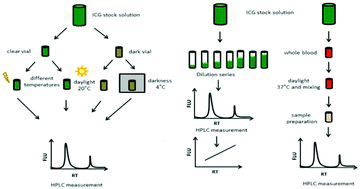Stability and degradation of indocyanine green in plasma, aqueous solution and whole blood†
Abstract
Fluorescence-based imaging has evolved into an important technology during recent years. Specifically indocyanine green (ICG) has invaded most fields of diagnostic and interventional medicine. Considering the numerous advantages of the substance like the rapid degradation and rare adverse reactions, ICG is currently the most commonly used fluorescing agent. High-performance liquid chromatography (HPLC) was used for measuring absorbance and fluorescence of ICG and its potential degradation compounds. Stability and degradation were evaluated under light exposure or in darkness at various temperatures. Under these conditions, degradation of ICG was evaluated over a period of 11 days. Additional, stability measurements of ICG were performed in EDTA whole blood samples at 37 °C incubation temperature while monitoring. Furthermore, we used mass spectrometric (MS) and nuclear magnetic resonance (NMR) analyses for the identification of supposed ICG degradation compound. Potential quenching effect of ICG was examined in aqueous and plasma solutions at concentrations ranging from 0.01–100 μg ml−1. When diluted in water and stored at 4 °C in the dark, ICG is stable for three days with only 20% of fluorescence intensity lost in this time-span. ICG incubated at 37 °C in whole blood under light exposure is stable for 5 h. In our study we observed the degradation of ICG into two degradation compounds with a mass of m/z 785.32 and m/z 1501.57, respectively. Based on our observations we suggest that ICG should be used within one or two days after preparation, if the ICG solution is stored at 4 °C.



 Please wait while we load your content...
Please wait while we load your content...